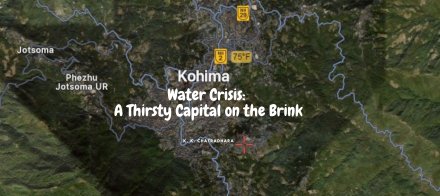 |
When Bideswar Perme and his wife Gomoni Pertin Perme moved from Old Borguli to their then newly-built bamboo stilt house in New Borguli village in 1992, the Siang river was around 5 km away. Now, it is just 100 metres away and can be seen from their home.
Located around 10 km from Pasighat, the district headquarters of East Siang in Arunachal Pradesh, the Namsing administrative circle in Mebo sub-division is home to nine census villages, including New Borguli, with a total population of around 7,500 as per the 2011 Census. The Permes of New Borguli, like so many other families in the area, make their living doing odd jobs and feed themselves through subsistence agriculture, growing just enough for their family. When they moved to the home, the Sibya river, a tributary of the Siang, flowed past the village. A flood on the Siang in 2000 reportedly claimed the lives of 30 people and also led to the death of the smaller Sibya tributary.
Bideswar said that the flood sped up the erosion that the Sibya was already causing and ultimately led to it being engulfed by the Siang when its breadth increased. Reports stated that the flood was caused by a breach of a dam on the Yarlung Tsangpo. Siang is known as the Yarlung Tsangpo in the upper reaches across the Tibet Autonomous Region of China.
The Yarlung Tsangpo begins its 3,969 km journey at the Mansarovar Lake region near Mount Kailash in Tibet, flowing through the Grand Canyon before turning at the ‘Great Bend’ near Mount Namcha Barwa. At this point, the river’s waters drop from about 2,900 metres to about 1,500 metres at the end of the Upper Gorge; it sharply falls further as the river rushes down through the Lower Gorge to the Indian border at an elevation of 660 metres (2,170 ft) when it enters Arunachal Pradesh with a new name, Siang.
It eventually flows into Assam, where the Dibang and Lohit rivers join it to form the mighty Brahmaputra; it traverses about 900 km towards the southwest before entering Bangladesh, where it is called the Jamuna. Strong currents in the upper reaches characterise this trans-national river, and the plains of Assam are known for being the widest river in India.
Every year, the floods in Assam destroy agricultural fields, livestock, people’s livelihoods, and claim countless lives of people. Despite being an annual feature, successive governments in the state and Centre across party lines have failed to formulate and implement a concrete plan to mitigate the flooding. While the flooding in the plains of Assam and the damages caused by the Brahmaputra are well-documented, the effects of the Siang in Arunachal Pradesh are not.
River of Death:
The topography in much of Arunachal Pradesh and the vital flowing rivers is that its land is prone to landslides and erosions. Landslides during the monsoon season almost invariably claim lives every year. However, since most habitations continue to be in mountainous regions or on valleys, the effects of the rivers’ strong currents in its five significant basins are not felt by the people. The effects of Siang, Dibang, and Lohit (all tributaries of the Brahmaputra) are often felt in the state’s low-lying areas. The villages of Borguli, Gadum, Kit, Namsing, Kongkul, Motup, Mer, New Borguli, Ngopok, Raling, Sigar, and Seram are located in these low-lying areas. In June 2000, when the floods came, the people of the nine villages and nearby Pasighat for the first time felt the impact of the mighty Siang and its volatile nature. Back then, the Siang rose by an unprecedented 100-120 feet and impacted four districts. More than 26 people reportedly lost their lives while three strategic bridges were swept away. An official estimate of the loss was Rs.139.50 crore.
Though New Delhi had called the incident a natural phenomenon caused by cloudbursts, a detailed study by the Indian Space Research Organisation (ISRO) indicated that the flash floods were triggered by the release of excess water collected in water bodies in Tibet.
While denying the allegation, an official of China’s Water Resources Department of the Tibet Autonomous Region government in Lhasa said the 60 metres high and 2.5 km wide dam was not an artificial dam but a natural one formed by a major landslide that occurred on 9 April 2000. However, since the year 2000, anomalies in the river’s behaviour and nature have been reported occasionally. In late 2017, people along the Siang began noticing that the river’s water had turned dark. Laboratory test results of samples of the Siang’s dark waters confirmed that the high turbidity had made it a river of death for aquatic life, besides making its water unfit for human consumption.
The sample test result showed that the nephelometric turbidity unit (NTU), which measures the suspended or dissolved particulate materials in water that scatter light making the water appear cloudy or murky, was 425 – more than 400 times higher than the permissible limit of five NTU for drinking water. Various theories and statements have been made to explain the cause of the high turbidity of the Siang, ranging from natural causes such as landslides to claims of Chinese infrastructural work on the river in Tibet. Claims were made, as reported in the international media, that the Chinese were looking to divert the river to feed some of their drier regions.
In 2018, another major flood brought raging waters and around 100 steel barrels with Chinese inscriptions indicating explosive chemical content. This flood was reportedly again caused by a landslide in Tibet on the other side of the border.
The waters again turned dark in early 2020 with no concrete explanation provided.
The lack of data sharing between the two countries and China’s ongoing infrastructural activities in Tibet close to Arunachal Pradesh has many on the Indian side concerned. So far, the response from the Indian authorities has been to announce counter-plans to build dams on the Siang. Instead of pushing for a concrete water data sharing policy, the thinking is to lay claims on the trans-national river by blockading it at specific points, Mohonto Pangin, a retired Group Captain of the Indian Air Force and a native of Namsing village, said. Simultaneously, data about the river’s water level is shared occasionally, and no concrete treaty exists between the two countries. He claimed that the deposit of construction materials on the river bed due to the Chinese activities led to a rise in the water levels.
“At Pasighat, below the Raneghat bridge, the Siang is 800 metres wide, but by the time it reaches my village, it becomes 13 km wide,” he said. Pangin theorises that the Chinese are possibly building a large tunnel to divert the river’s waters.
Local Response:
After the 2017 floods in Namsing, the villagers created embankments to control erosion of their land. In 2018, residents of around 200 houses of the nine villages of Namsing administrative circle came together to discuss their future vis-à-vis the Siang. After a series of meetings, called Kebang in the indigenous Adi language, it was decided that villagers would make whatever small contributions they could to build embankments.
Pangin and other Siang Ecosystem Environment and Nurturing Group (SEEANG) members had initially contacted the Brahmaputra Board, whose stated mission is “Integrated Management of Flood and River Basins of interstate/ international rivers of North East Region.” The retired Indian Air Force officer said the Board’s response was lukewarm, so the villagers took it upon themselves to take action. They initially built porcupine embankments using bamboo and tying them with 6 mm metal wires. After witnessing that the porcupine embankments were unable to withstand the Siang’s strength, Pangin said they learned from their mistakes.
Starting from Sigar, Raling, and Motum, the SEEANG built a 50-metre-long stone bund kept together with a steel mesh. Pangin said the bund was built in three days. “That’s when we realised that the villagers are expert craftsmen,” he said. However, the high cost of transporting these large stones led to them using sand-filled bags instead. The central government finally paid heed to the people’s plight. In August 2019, the Ministry of Development of North Eastern Region (DoNER), under its North East Special Infrastructure Development Scheme (NESIDS), sanctioned Rs.35 crore for ‘anti-erosion/ flood protection works.
There was explicit instruction that the funds were to be used for rebuilding the entire infrastructure damaged during the 2017 floods. The bund built came under criticism, and villagers felt it was to be blamed for the subsequent damages that occurred in 2020 during the pandemic.
A bund is a form of embankment made to act as a barrier against floods. However, the bund was raised at a location where the Siang turned towards the left bank and led to further erosion near Borguli, New Borguli, Seram, Kongkul, Namsing, Gadum, and Mer. Pre-monsoon rains led to an increase in the water level, and concerns grew. Eventually, a section of the government primary school at Sigar was washed away. Gomoni said she had hoped that the bund would help protect the villages but was disheartened to see it fail. “Maybe it was not built well,” she said.
Bideswar claimed that the residents in Sigar had told the engineers not to build the bund against the Siang flow but that they did not listen. He said technicians must measure the length, height, and requirement of materials, but they should have consulted the villagers while designing the bund. “It should have been built at an angle and not against the flow of the river. The river does not listen to anyone,” he said. Gomoni said the design flaws led to damages and loss of Rs.35 crore. “The engineers have gained their knowledge from books, but our villagers have first-hand knowledge since they work in the fields and live here,” she said.
At the Perme house, we are joined by Bapiyang Tayeng, who was earlier an Anchal Samiti member and is now a Zilla Parishad member. Tayeng said the villagers have been working to control the floods since 2015. The villagers lost so much land over the years and were left devastated when the bund was damaged in the first rains of the monsoon season.”Rs.35 crore has been damaged,” she said. She informed that among the casualties of the bund breach were the paddy fields in Motum and Raling. She believed around 1,000 hectares of land had been lost in the last two years from Sigar to Namsing.
At Namsing village, soaking in the afternoon sun, Katem Perme sits ideally as his family members run helter-skelter doing household chores. The 71-year-old came from Damro village up north in Upper Siang district to Namsing in 1962 when the Chinese forces had attacked India. He has been living here since and has 16 grandchildren. A prolific farmer, Katem has grown rice, ginger, mustard, maize, and bamboo during his lifetime.
In 2020, he lost around five hectares of agricultural land and was unable to cultivate rice. Like many in the area, he was unable to receive any government aid. “The government asked me for photographic evidence of the damages that the floods have caused. But, what do I take photos of? My fields are under the water,” he said. He predicts that if measures were not taken soon to control the annual flooding, Namsing village could be next.


